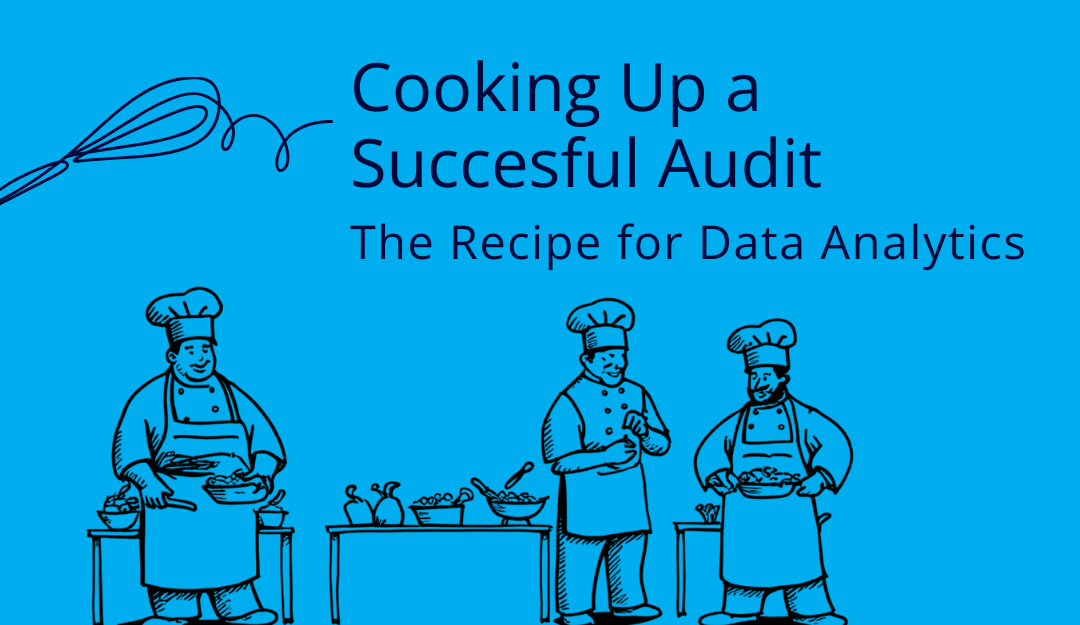In a recent conversation with Trent Russell on The Audit Podcast, I reflected on the transformative power of data analytics in internal auditing. It became clear during our discussion that this topic deserves a deeper dive. Just as a chef meticulously plans a meal, ensuring that every ingredient is accounted for and prepared, an auditor must also follow a detailed process to gather and analyze data in advance. In this post, I’ll share key strategies and insights I’ve gained over the years about effectively leveraging data analytics to enhance audit effectiveness. Whether you’re a seasoned auditor or just starting out, these principles will help you navigate the data-driven future of our field and add significant value to your organization’s risk management efforts.
Plan Ahead: Mise en Place for Your Audit
One of the most important steps in any successful audit is getting your data in order—just like mise en place, or prepping ingredients before cooking a big meal. At Capital One, we were obsessed with continuously improving our process to understand which data would be crucial for upcoming audits. This planning phase is the equivalent of making a “grocery list” of the essential data you’ll need.
Imagine being a chef who is preparing a complex dish. Before even starting to cook, you’ve got to gather all your ingredients and have them ready. Similarly, because our audit team obtained and reviewed data in advance, we were in a strong position right from the start. An analyst had already gone through the “ingredients” (the data), identified trends, and even noticed some anomalies—a spike in activity in one particular month that seemed impossible. Just as a chef might adjust the seasoning based on a quick taste test, we took an early look at the data to figure out what wasn’t adding up.
As it turns out, the data was accurate, and by reviewing it ahead of time, we learned a lot about the process and the business area. This “prep work” resulted in a thoughtful letter of notification with pointed questions and specific document requests—allowing us to enter the audit with clear insights and goals. Just as the right ingredients make for a successful meal, well-prepared data leads to better discussions, sharper observations, and stronger risk management.
Key Strategies for Crushing It with Data Analytics in Auditing: Following the Right Recipe
1. Get Your Data Early and Know It Inside Out- Just like a chef wouldn’t start cooking without their ingredients prepped and measured, you shouldn’t start an audit without having your data ready. Obtaining and profiling data early gives you the foundation you need to succeed from day one.
2. Listen to What Your Data’s Telling You- Chefs taste their food throughout the cooking process to ensure they’re on track. Similarly, you should dive into the data early on to see what it’s telling you. Basic analyses, like ‘group-by’ statements, can reveal crucial insights about customer complaints, fraud schemes, or churn rates that you might miss otherwise.
3. Have a Hypothesis, But Be Ready to Pivot- Every chef starts with a recipe, but the best ones know when to adjust based on taste. In auditing, you should begin with a hypothesis or theory, but as you dig into the data, be flexible. Often, you’ll uncover insights that lead to a more robust conclusion than your initial assumption.
4. Stay Focused on Your “Why”- It’s easy to get sidetracked by interesting but irrelevant findings. The best chefs know their goal—whether it’s a perfectly cooked steak or a delicate soufflé—and don’t get distracted along the way. Similarly, keep your audit objectives front and center. Cool data visualizations and trends are only useful if they tie back to your key risk areas or operational effectiveness.
A Pro Tip for Scoping Data Analytics in Audits: Selecting the Right Ingredients
When you’re documenting your audit universe, think of it like selecting your ingredients. You wouldn’t say, “I’m making dinner,” and stop there. Instead, you’d be specific: “I’m making chicken marsala with garlic mashed potatoes and roasted vegetables.” Similarly, don’t just say, “audit of the fraud department.” Be precise: “audit of the fraud risk management program for the last 18 months, focusing on trends in fraud loss, operational expense, and customer experience.”
This level of clarity helps your team identify data populations and prioritize the data they need to “shop” for, just like a chef shopping for key ingredients. With your data prepped ahead of time, you’re ready to hit the ground running when the audit starts.
The Impact of Getting This Right: Cooking Up Insights That Matter
I’ve been on all sides of this process—leading analytics teams, supporting auditors, working in compliance, and being a frontline executive getting audited. Just like a well-executed meal leaves your guests satisfied, leveraging data analytics effectively in an audit leads to better understanding, smarter questions, and timelier issue identification. The end result? Insights that really move the needle on risk management.
Wrapping It Up: Perfecting Your Audit Recipe
Embracing data analytics in internal auditing isn’t optional anymore—it’s a must if you want to deliver high-quality, insightful audits. Just like following a recipe to create a dish that wows your guests, the audit process requires thoughtful preparation, flexibility, and a clear vision of the final product.
Get your data early, explore it thoroughly, stay open to what it reveals, and always keep your objective in mind. Do that, and you’ll be amazed at the value you can bring to your organization. Remember, we’re not just crunching numbers—we’re telling a story with data, a story that drives action and improves how organizations manage risk.
Reposted from LinkedIn with permission from the author, Mark Houston.

